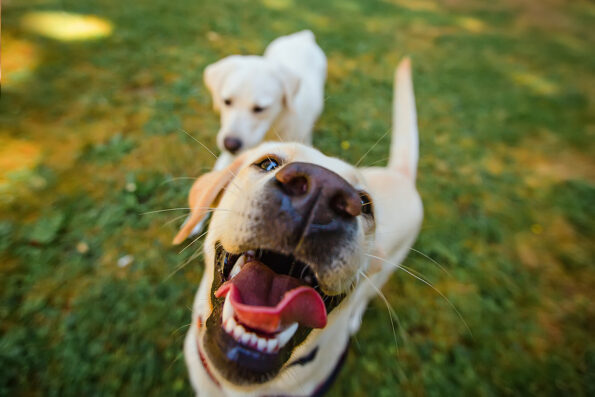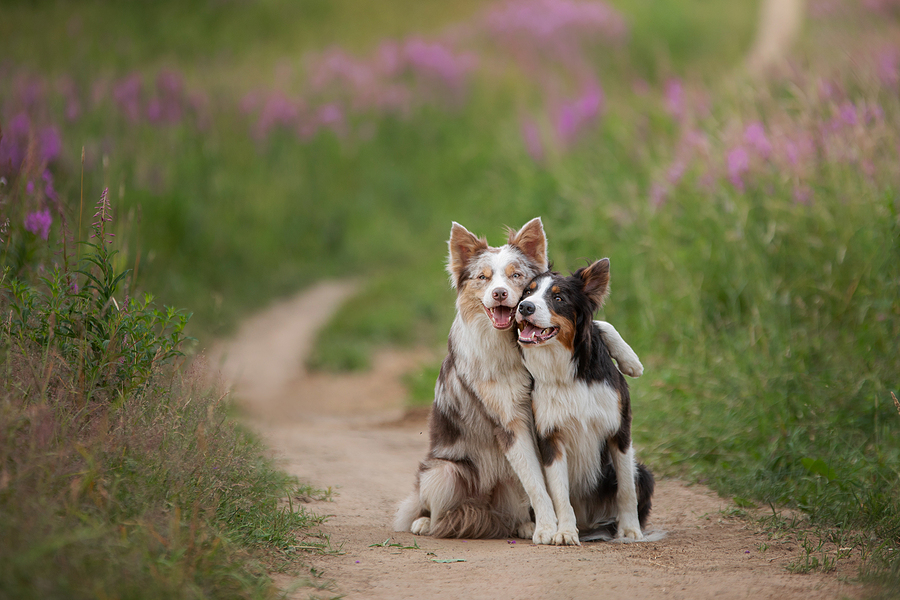“Some of our greatest historical and artistic treasures we place with curators in museums; others we take for walks.”
– Roger A. Caras
If your dog doesn’t want to walk a step further when you are out on a walk, it could be a sign that it needs a break.
While walking your dog has excellent benefits for its physical and mental health and well-being—and yours as well—there is such a thing as too much exercise.
Here are seven signs you need to watch out for that tell you your dog needs a break on a walk.
1. Vigorous Panting
One of the signs your dog doesn’t want to go for a walk or simply needs a break during its walk is heavy panting. If your pet is unable to catch its breath, it is a sign that it has over-extended itself and needs a quick break.
In this case, give it five to 10 minutes to recover or as long as it needs to resume breathing normally. Once it seems fine, both of you can continue your walk. Or if your dog looks tired even after many minutes have passed, it’s time to go home and let it rest.
2. Slow Movements
Why doesn’t my dog want to walk quickly with me? If you are playing or walking with your dog and it suddenly starts to slow down or lag behind, it is a sign that your four-legged friend is exhausted. In this situation, it will need to take a break or stop its exercise session for the day.
Some dogs can’t help but get up and resume playing or walking. So, you’ll have to pay close attention to such subtle signs to prevent your dog from getting too much exercise.
3. Refusing to Move
“Dogs do speak, but only to those who know how to listen.”
– Orhan Pamuk
Why my dog doesn’t want to walk? A dog that refuses to move and just sits there or lays down is one that has exercised more than it should.
When my dog doesn’t want to walk, it will not get up or follow me home. This is a dog’s way of telling its owner that the walking session has been more than it can handle.
A dog may sometimes also stop walking when it’s experiencing joint pain. Arthritis and hip dysplasia are common causes of joint pain and can be extremely painful for dogs.
If your dog favors one leg over the other when it stops or lets out a whimpering or yelping sound before stopping, these are signs of joint pain.
What to do when the dog doesn’t want to walk? The best thing would be to carry it or drive it home. If it’s too heavy to carry and you didn’t bring your car, call someone to pick you and your dog up. Also, remember to never force your dog to walk when it cannot do so.
If your dog appears to be suffering from joint pain, contact your vet soon and schedule an exam. A comprehensive examination will help your vet find out the underlying cause of the joint pain. They will then prescribe a suitable treatment plan for your pet.
4. Limping
If you see your dog limping on a walk, it was most likely injured, possibly during exercise. Continuing your walk in such a situation will only worsen its injury.
If you find it limping, inspect your dog’s affected paw for wounds or embedded objects like a stone or thorn. If you can’t spot anything, let your dog rest for a week or so. It might be a minor injury that will heal on its own with proper rest.
But if your dog continues limping even after a week or so of rest or the limp becomes severe, you should take it to your vet immediately.
5. Looking Stiff Or Sore
Sometimes, dogs that have exercised too much don’t show any signs of injury right away. But a few hours or even days later, they may appear sore or stiff.
Whether you’re on a walk or at home, when you see your dog looking stiff or sore, stop your walk and check its paws and legs for any wounds like a hurt paw pad or nail.
If it is a minor injury, it usually takes a few days of rest for the injury to heal. Nonetheless, if you find any injuries, click pictures and send them to your vet, asking for first aid instructions.
But if your dog is having trouble walking, whimpers, or refuses to eat, it might have more severe injuries. If your dog suddenly doesn’t want to walk or eat, take it to a vet. If you can’t find the source of the wound, you should schedule an appointment with your vet anyway.
In the meantime, call a family member or friend to pick you and your dog up to prevent the injury from worsening.
Also, avoid walking too much with your dog all of a sudden, as it puts excessive strain on your pet’s joints and muscles, leading to injuries.
6. Wear And Tear On Paw Pads
Some dogs tend to play more than their bodies can take. They will keep walking, running, or playing about until their paw pads tear. Some high-energy dogs who love to exercise will keep running despite the pain and discomfort.
Injuries to a dog’s paw pads are often very painful. But dogs cannot rest their paws as easily as humans can. This worsens the injury while making walking an arduous task.
Why doesn’t my dog want to go for a walk? Check its paw pads for wear and tear, which may be causing it to reject your offer.
Overworked pads may look red, worn away, torn with visible flaps of skin sticking out, or appear thinner than normal. You may even see pus or swelling if the paw pads are infected.
In this case, let your dog rest until its paws heal fully. Also, take it to a vet soon to keep the injury from getting worse. Make sure to protect its paws, too, the next time you’re out on a walk with your dog.
7. Heat Sickness
The heat outside could be another reason why a dog doesn’t want to walk. Heat stroke and heat exhaustion can commonly affect dogs during summer.
Dogs tend to overheat in the warmer months, with their body temperature potentially rising to even above 106 degrees Fahrenheit, which is life-threatening. This can possibly cause dehydration, breathing difficulties, swelling in the brain, tissues, and organs, abnormal blood clotting, or even hyperthermia.
Brachycephalic breeds or breeds with shortened snouts, like Pugs, Bulldogs, Boxers, Pekingese, and Shih Tzus are more susceptible to overheating. This is because their shorter muzzles restrict airflow in and out of their mouths. This makes it difficult for them to cool off as efficiently as other breeds, which leads to overheating.
Your dog’s age also determines whether it is prone to overheating. Puppies and senior dogs have a hard time regulating their body temperatures. So, excessive exercise can make them overheat, too.
Overweight dogs, thick-coated dogs, and dogs with medical conditions can also overheat more quickly than others.
Avoid taking your dog out for a walk in the summer—especially if it is a pup, an older, sick or overweight dog, or a brachycephalic or thick-coated breed.
Also, watch out for the following warning signs of overheating:
- Excessive panting
- Excessive drooling
- Confusion or a lack of focus
- Lack of coordination
- Glazed eyes
- Tongue or gums that turn bright red, gray, purple, or blue
- Diarrhea or vomiting
- Loss of consciousness
How to walk a dog that doesn’t want to walk due to heat sickness? If your dog doesn’t want to walk because it is overheated, avoid exerting it further and take it to a cool, shaded area. Give it water to drink and let it lay on a wet towel, or let it take a dip in a pool or a body of freshwater.

Check its tongue for any symptoms. A dog tongue health chart will help you understand the warning symptoms you need to look out for. Also, get your pet to a vet at the earliest, especially if it has severe symptoms.
Conclusion
There are many reasons that your dog doesn’t want to walk like tiredness, heat exhaustion, muscle soreness, pain, or injury. You only need to watch out for the signs to understand when your dog needs to take a break on a walk or simply stop altogether for the day.
Make sure to keep a track of its walking distance and get to know its exercise limits. This is especially true for high-energy dogs that love exercise, pups, dogs that are old, overweight, or sick, short-snouted breeds, and dogs with thick coats.
This will help you ensure your dog gets the right amount of exercise without pushing its limits too much.
Image Source: BigStockPhoto.com (Licensed)
Related Categories: Pets & Animals, Reviews








